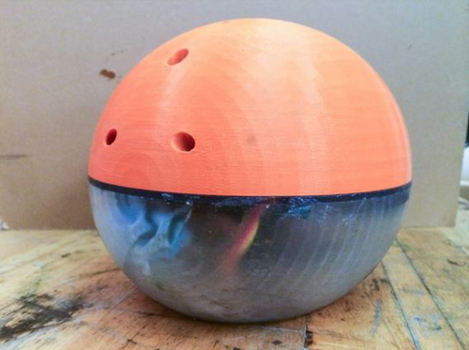They may not be as quick or efficient as airport sniffer dogs, but robots are getting ready to take the fight against drug smuggling underwater.
Researchers at MIT are working on submersible machines that could use ultrasound to find drugs hidden on ships.
Their prototype, which looks like a bowling ball, is designed to move along the hulls of ships. It could use ultrasound scanning to detect hollow spaces in false hulls and propeller shafts where drugs might be stashed.
Developed by grad student Sampriti Bhattacharyya and Harry Asada, a professor of engineering at MIT, the robot is divided into two halves, one waterproof and the other water-permeable.
The former houses a rechargeable lithium battery and electronics, while the latter contains six pumps that force water out through tubes, driving the bot forward.
The robot can move between 0.5 and 1 metre per second while pressed against the hull of a ship, and its battery charge lasts about 40 minutes.
The submersible was made using 3D-printed structural elements, meaning it could be manufactured for as little as $600. That’s cheap enough to allow a swarm robot approach, with dozens of machines working in unison to ferret out contraband.
“It’s very expensive for port security to use traditional robots for every small boat coming into the port,” Bhattacharyya was quoted as saying in an MIT News article.
The prototype was recently presented at the International Conference on Intelligent Robots and Systems (IROS) in Chicago, but tests so far have focused on whether it can travel in a straight line and stay in contact with an underwater surface. It still has to be equipped with an ultrasound sensor.
The researchers hope to add improvements such as batteries that can recharge wirelessly and changes to the propulsion system that would extend operating time to 100 minutes per charge. Performing ultrasound scans without being in contact with a hull is another possible enhancement, since ships can be fouled with barnacles that would hamper the bots.
The anti-smuggling robot follows an effort by consulting company Boston Engineering and the US Department of Homeland Security to develop a tuna-shaped underwater vehicle called BIOSwimmer. That vehicle is designed to inspect flooded bilges and tanks of ships and to use a camera and sonar to detect hull anomalies that might signal the presence of drugs.
IDG News Service







Subscribers 0
Fans 0
Followers 0
Followers